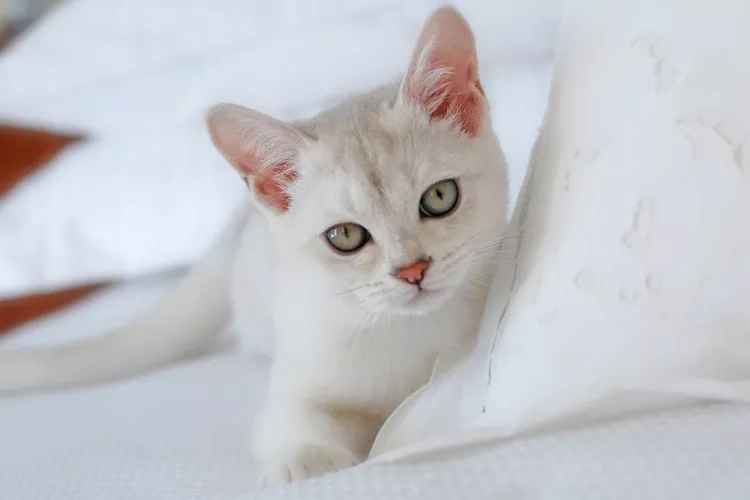Burmilla: Cat Breed Profile, Characteristics & Care

The beautiful burmilla is one of the newest breeds to be officially recognized by the Cat Fanciers' Association. It came about as the result of an accidental mating between a Burmese and a Chinchilla Persian in the 1980s. This sturdy yet elegant cat boasts a silvery-white coat and almost appears to be wearing eyeliner—and nose liner! The breed, while still relatively rare, is beloved by its enthusiasts for being playful, inquisitive, and gentle.
Breed Overview
Personality: Friendly, playful, curious, and sociable with an independent streak
Weight: Up to 12 pounds
Length: Up to 20 inches
Coat Length: Short hair or semi-long hair
Coat Colors: Silver-white with tips or shading that can include black, blue, chocolate, cream, lilac, and tortoiseshell
Coat Patterns: Shaded or tipped
Eye Color: Green
Lifespan: Up to 15 years
Hypoallergenic: No
Origin: United Kingdom
Burmilla Characteristics
The burmilla breed is affectionate and sweet-natured. It loves attention but not in the sometimes demanding manner of the Burmese. It tends to be relatively quiet, although it is generally more playful and curious than the Persian. Burmillas can even be a bit mischievous and are known for having slightly goofy, almost clown-like characters.
Although they do enjoy the company of their people, they have an independent streak, so they make great cats for working owners. They also tend to get along well with other cats and dogs, providing the introductions have been done carefully.
History of the Burmilla
The burmilla has a rather noble and recent history. The breed began quite by accident in the early 1980s when a Chinchilla Persian and a Burmese, owned by a baroness in the United Kingdom, mated unexpectedly.
The resulting kittens had darkly shaded, thick, short coats. They were so striking that the Baroness, who already bred Persians, decided to develop a breeding program for this type of cross.
They gained championship status in the United Kingdom in the 1990s, but it wasn't until 2011 that the Cat Fanciers' Association recognized the burmilla breed.
Burmilla Care
Short-haired burmillas require little in the way of grooming; an occasional brushing will help remove loose hair and keep their coats shiny. Longer-haired burmillas benefit from regular (weekly) brushings and an occasional bath to keep their silky hair free of tangles.
Burmilla cats often retain a kitten-like exuberance for life well into adulthood, making them fun pets. Because of this playful and curious streak, though, you should make sure your burmilla is getting enough stimulation and enrichment around the home. A bored burmilla could seek out its own means of entertainment—and that could include destructive behavior.
Common Health Problems
So far, the burmilla does not appear to have any specific genetic problems. Periodontal disease is one of the most common health problems for any cat breed. Making sure you provide a good quality diet and trying to introduce a dental hygiene regime from a young age can be beneficial.
If your cat tolerates having its teeth brushed a few times a week, this can make a big difference. You should always introduce the toothbrush gradually, keeping sessions short. If you pair it with lots of positive rewards, then your cat should learn to accept these sessions more willingly.
Appearance
The burmilla is a muscular yet elegant medium-sized cat with a thick double-layered coat that feels soft and silky. Occasionally, burmillas can have a slightly longer coat that is classed as semi-long hair. This is a result of the recessive gene from the Chinchilla.
Burmillas come in a variety of coat colors and patterns. They are either tipped or shaded. If they have a tipped coat, this means they have a light color that covers a silver or golden undercoat. The silver-tipped cats can often look close to white. Shaded burmilla have a darker color pattern that primarily appears over the top of their back and shoulders and on the outside of their legs.
Diet and Nutrition
The burmilla, like all cats, will need a quality, high-protein diet. They are not as prone to obesity as some other breeds, but care should still be taken to ensure you do not overfeed them.
Where to Adopt or Buy a Burmilla
Because of their rarity, you may have to travel a fair distance or be on a waiting list to secure a burmilla kitten. The Fanciers' Breeder Referral List (FBRL) maintains a directory of cat breeders, including the few burmilla breeders in the United States.
Burmilla Overview
The burmilla is a very adaptable breed, and they make excellent family pets. The Burmese and the Chinchilla Persian both have very different personalities, and the burmilla has inherited positive attributes from each.
Affectionate and playful
A healthy breed
Low maintenance coat
Rare (few breeders in the US)
Their curiosity can sometimes lead to trouble
More Cat Breeds and Further Research
If you’re interested in similar breeds, check out:
Otherwise, check out all of our other cat breed profiles.
-
Are burmillas friendly cats?
Burmillas are very friendly and playful, but they can also be left alone for short periods because they are fairly independent.
-
How much does a burmilla cat cost?
Though rare, a burmilla cat costs between $800 and $1,200, which is comparable to many other breeds.
-
Do burmilla cats have genetic health issues?
The burmilla breed is relatively new, but no genetic health problems are apparent in the breed.
:strip_icc():format(webp)/exotic-shorthair-cat-resting-on-floor-585840669-5ad0afd7c064710038e382e7.jpg)